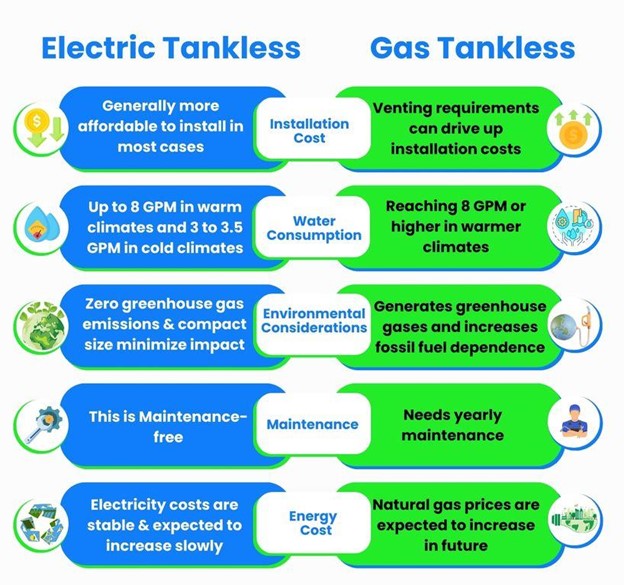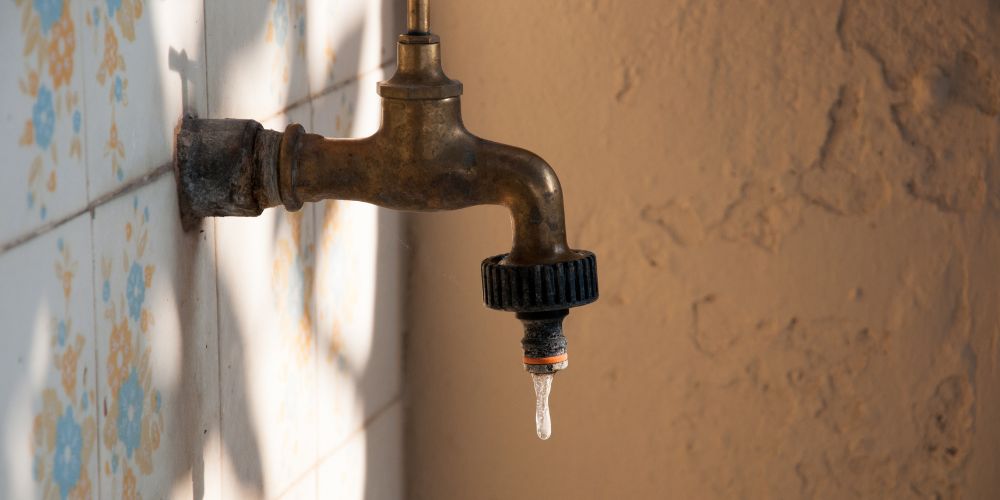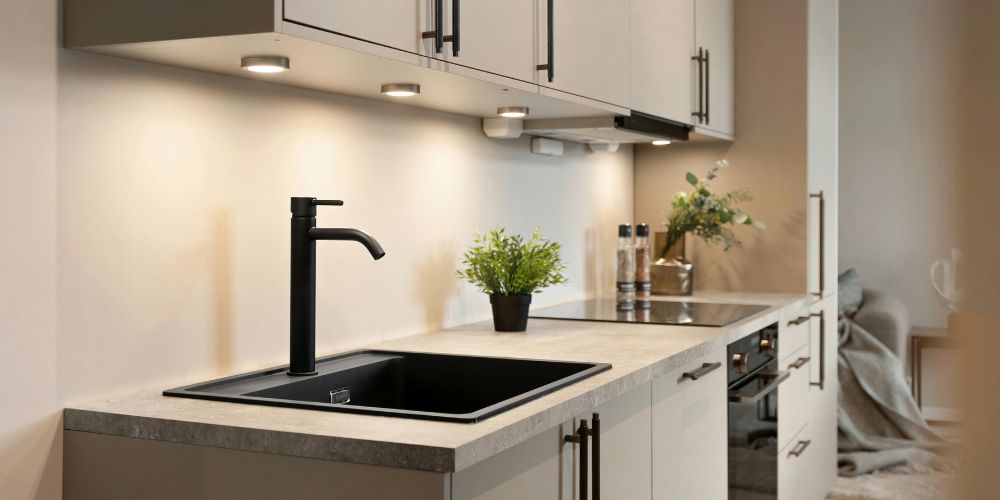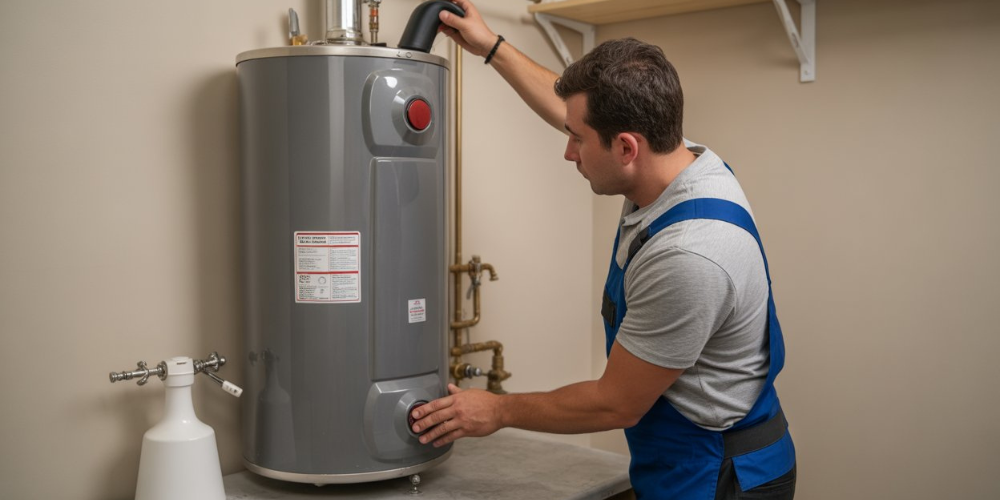Thinking about installing a water heater but unsure whether to go with an electric or gas tankless option? Both types come with their advantages and downsides. The best choice for you depends on factors like your household’s hot water needs, energy costs, and installation expenses. Let’s dive into the key differences between electric and gas tankless water heaters to help you make the right decision!
Difference Between Electric VS Gas Tankless Hot Water Heaters: What You Need to Know
When deciding on a tankless water heater, understanding the differences between electric and gas models is crucial. Let’s dive into the key differences between electric and gas tankless water heaters to help you make the right decision!

1. Cost of Installation:
Electric tankless water heaters:
Electric tankless water heaters are powerful appliances that operate on demand. Unlike traditional water heaters that work continuously, these units need to heat water quickly, resulting in high peak electrical consumption. While they use significantly less power overall, homes or businesses in colder climates or those with high hot water demands may require a 200 AMP electrical service to effectively run an electric tankless water heater. For areas with lower demand or warmer climates, a 100, 125, or 150 AMP service is usually sufficient. It’s crucial to consider your existing electrical setup, as many homes and businesses may not have the necessary power available, and upgrading can be costly.
Gas tankless water heater:
Installing a gas tankless water heater can be impractical if there isn’t already a natural gas or propane service in place. Often, you’ll need to increase the diameter of the incoming gas line to meet the higher fuel demands of a gas tankless water heater. This modification can also lead to significant expenses.
2. Water Consumption Habits:
Electric tankless water heaters:
Most homes and small businesses don’t need a lot of hot water at once since they usually use appliances one after another. A well-sized electric tankless water heater can deliver about 3.0 to 3.5 gallons of hot water per minute in colder climates and up to 8.0 gallons per minute in warmer areas. This is typically enough to meet the hot water needs of most situations.
Gas tankless water heater:
Some gas tankless water heaters can provide higher flow rates; however, they tend to be more expensive to install because of the complex venting, gas line, and combustion air requirements involved.
3. Environmental Considerations:
Electric tankless water heaters:
Switching from a traditional water heater to an electric tankless system is an environmentally friendly decision. In many areas, especially those that produce electricity from clean sources like hydro, nuclear, or wind power, choosing an electric tankless heater is even better for the planet. Additionally, electric tankless water heaters are smaller in size, meaning they require less energy and resources to manufacture.
Gas tankless water heater:
As worries about global warming rise, we’re becoming more aware of how burning fossil fuels, such as natural gas and propane, contributes to greenhouse gas emissions. As a result, consumers are being urged to cut back on these emissions to help protect the environment for future generations.
4. Maintenance:
Electric tankless water heaters:
Maintaining an electric tankless water heater is quite simple. Aside from regularly checking the inlet screen filter to ensure it’s free of debris, no other maintenance is necessary. If there’s a malfunction, electric tankless water heaters are generally easier to troubleshoot, diagnose, and repair.
Gas tankless water heater:
In contrast, gas tankless water heaters require annual inspections to ensure safe fuel combustion and proper operation to their gas counterparts.
5. Source of Energy:
Electric Tankless Water Heaters
Tankless electric water heaters can last over 20 years, so it’s crucial to think about the long-term costs of electricity. The US Energy Information Administration’s historical data shows that electricity prices rose just 12.8% between 1994 and 2005, indicating a more stable pricing trend. Although electricity prices are expected to rise, they do so at a slower pace compared to natural gas. With fewer fluctuations and a more predictable cost structure, operating an electric tankless water heater may prove to be the more economical choice over time. As the energy landscape changes, you might find that an electric tankless heater is not only cheaper to buy and install but also more affordable to run in the long run.
Gas Tankless Water Heaters
On the other hand, gas tankless water heaters also have impressive longevity, but you need to consider the long-term cost of natural gas. Prices for natural gas saw a staggering 114.5% increase between 1994 and 2005. Analysts predict that natural gas demand will outpace supply by 2 to 3 times, leading to even sharper price hikes in the future. Moreover, gas prices can fluctuate dramatically due to supply interruptions and geopolitical issues, such as conflicts in the Middle East. This volatility can lead to significant spikes in utility bills in a short time frame. Consequently, while gas tankless heaters may initially appear attractive, they could end up costing you more over time compared to electric models.
Also, read What Are The Different Kinds Of Water Heaters?
How Do Electric and Gas Tankless Water Heaters Warm Your Water?
Gas tankless water heaters:
Tankless water heaters provide hot water on demand, without needing a storage tank. When you turn on the hot water, cold water travels through a heat exchanger, where it’s quickly heated by either a gas burner or an electric element.
With tankless water heaters, you get a steady stream of hot water whenever you need it—no waiting for a storage tank to fill up. However, keep in mind that there are limits to how much hot water they can provide at once.
Generally, tankless water heaters can deliver hot water at a rate of about 2 to 5 gallons (7.6 to 15.2 liters) per minute. Gas-powered models usually provide a higher flow rate compared to electric ones, making them a great option for larger households or higher hot water demands.
Electric tankless water heaters:
An electric water heater usually includes a storage tank, one or two heating elements, a thermostat, and various safety features. The electric heating elements are responsible for warming the water inside the tank, guided by the thermostat. When you turn on a hot water tap, cold water flows into the bottom of the tank, ensuring that hot water is always available. As the water level increases, the thermostat checks the temperature and activates the heating elements to bring the water up to your desired warmth.
These heating elements work using a process called electrical resistance heating. When electricity flows through them, their resistance generates heat, much like how a toaster operates. Typically made from a metal alloy, these elements are encased in a protective cover to keep them from direct contact with water, which helps prevent corrosion and extends their lifespan.
Gas vs Electric Tankless Hot Water Heater: Comparing Costs
When it comes to upfront costs, electric tankless water heaters tend to be more affordable than gas models in the U.S. However, long-term expenses can vary depending on energy prices, which fluctuate over time.
When thinking about the cost of running a tankless water heater, it’s not just about looking at today’s energy prices. Right now, natural gas tankless heaters are about 10-15% cheaper to run than electric ones. However, electric tankless heaters are usually more efficient, with over 99% efficiency compared to gas heaters, which are around 80-85%. Even though natural gas is typically cheaper than electricity, the higher efficiency, longer lifespan, and lower installation costs of electric heaters can easily balance out the small monthly savings from gas heaters, which would only be a few dollars for most households.
Gas tankless water heaters are typically more cost-effective in regions with high hot water demand and higher electricity costs. On the other hand, electric models are ideal for areas with lower energy costs and water usage, particularly in rural locations where infrastructure may be limited. Both options have their advantages depending on your specific needs. Understanding the key differences between electric and gas tankless water heaters can help you make the best choice for your home.
The higher cost of gas tankless water heaters is largely due to the complexity of installation. This process involves additional steps like connecting gas lines and ensuring proper ventilation. Factors such as the brand, necessary modifications, water filtration systems, and accessories also influence the total cost for both electric and gas models.
Wrapping Up
Deciding between an electric vs gas tankless hot water heater ultimately hinges on your specific needs, preferences, and circumstances. Electric models tend to be easier to maintain, more efficient in energy use, and require less initial installation work, making them a great choice for many households. On the other hand, gas tankless water heaters excel in delivering higher flow rates and may be more cost-effective in regions with lower gas prices.
Consider factors like your household’s hot water demands, energy costs, and installation requirements to make an informed decision. Regardless of your choice, both options offer the advantage of endless hot water, energy efficiency, and space-saving designs.
If you’re ready to explore your options further and find the perfect fit for your home, reach out to us at Plumbsmart. Our experts are here to guide you through the process or call us at (210) 810-0810 for the best solutions for your needs!





